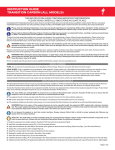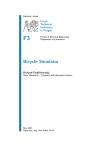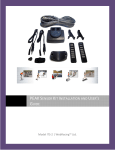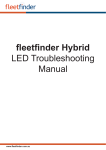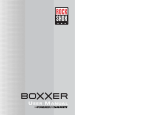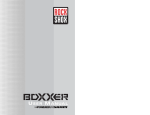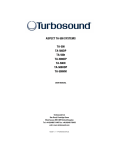Download Product Manual - Cervelo Cycles
Transcript
Instruction FORK 12-12-2007 12:28 Pagina 1 3T FUNDA OWNER’S MANUAL Note to shops/assemblers: Please pass these instructions to the consumer along with the completed bicycle for their reference. IMPORTANT CUSTOMER INFORMATION WARNING: Carbon bicycle forks are subject to wear and stress during their lifetime. If the fork’s useful life is exceeded, it can suddenly and catastrophically fail, potentially causing serious injury or death to the rider. Scratches, cracks, fraying, and discoloration are signs of stress-caused fatigue and indicate that the fork is at the end of its useful life and needs to be replaced. While the materials and workmanship of your fork are covered by warranty, this is no guarantee that the fork will last the full term of the warranty. Product life is often related to the kind of riding you do and to the treatment to which you submit the bicycle & fork. The fork’s warranty is not meant to suggest that the fork cannot be broken or will last forever - it only means that the fork is covered subject to the terms of the warranty. For warranty details please visit www.thenew3t.com. For information relating to product life please consult with your dealer. INTENDED USE 3T forks are designed and built for road riding, racing, and time-trialing. They are intended to be used for rides on smooth surfaces such as paved roads. While riding, take care to avoid pot holes, sewer grating, railroad tracks, expansion joints, road or sidewalk construction, debris and other obstructions that could catch your front wheel and cause a severe impact to the fork. 3T forks are not designed for use on rough or loose off-road surfaces, or for stunts, jumping, or other aggressive riding. These unintended actions can put huge and unpredictable stress on the fork, and risks serious damage to both the fork as well as to the rider. WARNING: Frequent inspection of your fork is important for your safety. Perform an inspection of the fork and bicycle before every ride. Periodic, more detailed inspection of your bicycle is also important. How often this more detailed inspection is needed depends upon you. Because your dealer cannot track your use, you must take responsibility for periodically bringing your bike to your dealer for inspection and service. Your dealer will help you decide what frequency of inspection and service is appropriate for how and where you use your bike. NOTE: See also Care & Maintenance for details on how to identify damaged parts. For your safety and understanding, please read these instructions in their entirety. Ignoring these WARNINGS can lead to fork failure, which can result in serious injury or death. 3T cannot accept any liability in the event of failure to comply with the instructions in this manual. FORK INSTALLATION PROCEDURE When installing the 3T Funda fork, please observe the following guidelines to ensure safe operation. Ensure you understand all instructions before beginning the fork installation. If in doubt consult your dealer for assistance. 3T recommends the use of the supplied alloy insert sleeve and pre-installed star nut to preload the headset. The use of a compression plug (not provided) in place of the insert sleeve is permitted, but this substitution will not provide the same resistance to clamping damage due to over-tightening of the stem. MATERIALS LIST Provided with fork: 3T Funda Owner’s Manual 75mm fork insert & star nut Sandpaper (120-180 Grit) Epoxy packet (Hardman, Fast Setting Red Package #04001) Isopropyl Alcohol wipe Wooden mixing stick 18mm brake nut Stem top cap M6 stem top cap bolt of the insert (tapered end). Carefully cut the insert using a hacksaw, and file the cut end to remove any sharp edges. Note that the insert must be cut from the bottom only. Test fit the insert again to ensure it will fully seat in the steerer. 7)Ensure all bonding surfaces are cleaned of all debris and finger oils. Use isopropyl alcohol to clean the inside of the steerer tube and the outside of the insert as necessary. Note that the cleaning of both parts should be completed within 5 minutes of applying the epoxy. Once cleaned, the bonding surfaces must not be touched before the epoxy is applied. 8)Using gloves, the wooden mixing stick, and a clean disposable surface; fully mix the epoxy in the kit supplied with the fork according to the package instructions. Apply a layer to the outer surface of the insert. Concentrate the epoxy towards the bottom (tapered) end of the insert. Excess epoxy may be added to the inside of the steerer tube. 9)Carefully slide the insert into the steerer while rotating it slowly until the flared end sits flush with the top of the steerer. The rotation will help spread the glue over the bonding area – which needs to be completely covered. Attempt to minimize any drips due to epoxy squeezing out. 10)Wipe away any excess glue from the outside surface of the steerer tube with an isopropyl alcohol wipe. Once complete, visually re-check that the insert is sitting flush in the steerer tube. 11)Set the fork aside and allow it to sit undisturbed for the full curing time as noted on the epoxy packet. Do not attempt to fit the fork into a bike prior to the completion of the full curing cycle. NOTE: The cure time for a red packet of epoxy is 4 hours at 25°C ambient temperature – colder temperatures will increase the cure time. WARNING: Moving the insert before the epoxy has fully cured will damage the bond, and will greatly reduce the strength of the fork, potentially resulting in a failure. Do not touch the fork while the epoxy is curing. ASSEMBLY WARNING: Improper fork installation could cause a failure that results in severe injury or death. 1)Check the stem, spacers and headset components to make sure there are no sharp or rough edges on any of the surfaces which could cut or damage the steerer tube. If any rough edges are detected, have the components repaired (sharp edges removed) or replaced before proceeding. 2)Press the upper and lower headset bearings into the frame, and insert the fork into the head tube. 3)Slide the compression ring onto the steerer, and down until it fully seats in the top of the upper headset bearing. The split in the compression ring must be oriented toward to left or right side of the steerer – never towards the front or back. 4)Slide the upper bearing cover onto the steerer until it sits flush on top of the compression ring and upper headset bearing. Ensure that the fit of the assembly is snug, and that there is no play in the system. 5)Slide the spacers and stem onto the steerer. Do not use grease on the fork steerer. The use of Tacx Carbon Assembly CompoundTM or equivalent friction paste is recommended to help secure the stem. 6)Visually check to confirm that the distance between the top of the stem and the top of the alloy insert is between 2 and 4 mm. If not, add or remove spacers to achieve this number. 7)Lightly grease the threads of the stem top cap bolt, and the stem clamp bolts. 8)Place the stem cap on top of the stem and insert the greased bolt through the cap to engage with the star nut. Tighten the bolt only enough to remove all play from the headset, and ensure that the fork still rotates freely. 9)Visually check the alignment of the stem with the front wheel and make any necessary adjustments. WARNING: To avoid damaging the fork, never try to align the stem without first fully loosening the stem’s steerer clamp. 10)Tighten the greased stem bolt(s) to the steerer using a torque wrench. 4 to 5 Nm tightening torque is recommended. Do not exceed the maximum torque rating specified by the stem manufacturer. WARNING: Correct tightening force on fasteners – nuts, bolts, screws – on your bicycle is very important. Too little force, and the fastener may not hold securely. Too much force, and the fastener can strip threads, stretch, deform or break. Either way, incorrect tightening force can result in component failure, which can cause you to loose control and fall. In case of a disagreement or a conflict between any literature on recommended torque values, always use the recommended torque specification as printed on the component or recommended by the component manufacturer over any recommendation listed in this manual. Safety Equipment: Disposable gloves Face mask (to prevent dust inhalation) Safety glasses 11)As a final check ensure that the fork rotates freely in the head tube without any play or binding. If any problem is detected, loosen the bolts and perform steps 8) to 11) again. 12)Lightly grease the threads of the front brake bolt. 13)Fit the front brake onto the fork. Insert the supplied brake nut (18mm) into the rear of the fork’s brake hole to engage the brake bolt. Tighten the nut and complete the brake installation and assembly according to the brake manufacturer’s instructions. 14)Install the front wheel into the fork dropouts and securely fasten the quick-release mechanism according to the manufacturer’s instructions. 15)Close the brake quick-release mechanism and test ensure the brake is operating properly as per the manufacturer’s instructions. Tools Needed: Crown race installation tool Threadless saw guide for fork steerers Composite or fine-tooth hacksaw Metric hex wrenches Torque wrench (1-10 Nm range) with metric hex key attachments High-quality bicycle grease Carbon assembly compound (optional) CARE & MAINTENANCE All riders must understand the fundamental realities of composites: Composite materials constructed of carbon fibers are strong and light, but when crashed or overloaded, carbon fibers do not bend, they break. At and near the break, there will be rough, sharp edges and possibly delamination of carbon fiber or carbon fiber fabric layers. There will be no bending, buckling, or stretching. Repeated loading of the fork during use can also create fatigue damage over time. Proper inspection of the fork is critical to ensure your safety while riding. MEASURING NOTE: This procedure assumes that the frame was adequately prepared to accept the bearings (i.e. head tube was faced and reamed if necessary to ensure the faces are square and inner dimensions correct). 1)Press the upper & lower headset bearings into the head tube. 2)Press the crown race onto the fork crown race seat using an appropriate installation tool. Take care to ensure that the fork is properly supported during installation to avoid damage to the dropouts. 3)Test fit the fork into the head tube with all headset components, the required number of spacers, and the stem desired by the customer (following all manufacturers’ instructions). 4)Apply the minimum pressure needed to ensure the complete assembly is fully seated, and then tighten the stem’s steerer clamp bolts just enough to hold that position. Mark the steerer tube at the top of the stem. 5)Disassemble all parts and clearly mark the fork steerer tube at a point 4mm below the first mark made in step 4). Take care to verify that this measurement is correct - as this lower, final mark defines the cut line for the steerer tube. NOTE: Cutting the steerer tube too long will result in a loose headset; cutting the steerer tube too short renders the fork unusable. CUTTING WARNING: Avoid breathing the dust created during cutting carbon composite materials. Before each ride: Squeeze the front brake and rock the bike forward and back. Does everything feel solid? If you feel knocking with each forward or backward movement of the bike, you probably have a loose headset. Readjust the headset as per the Assembly instructions above or have your dealer check it. Lift the front wheel off the ground and swing it from side to side. Does it feel smooth? If you feel any binding or roughness in the steering, you may have a tight headset. Readjust the headset as per the instructions above or have your dealer check it. Check the fork for any deep scratches, cracks or discoloration. These are signs of stress-caused fatigue and indicate that it is at the end of its useful life and needs to be replaced. Check the alignment of the front wheel within the fork to ensure no parts are rubbing. Readjust the wheel position if necessary. During each ride: Stop and immediately investigate any new or changes in sound (squeaking/rattling), or feel (soft feel/vibration/flexibility) occurring in the area of the handlebars, stem, fork, or front wheel. Do not ride the bicycle until the cause has been identified and properly resolved. After a crash or significant impact: First, check yourself for injuries, and take care of them as best you can. Seek medical help if necessary. Next, check your fork for damage on the spot. Do not ride if any problems with the fork are detected. Bring the fork to your dealer for professional inspection. Following any significant impact, take your bike to your dealer for a thorough check. The entire fork must be inspected for damage – this requires complete remove from frame to check all surfaces for cracks or other signs of damage. Replace the fork if any problems are detected. WARNING: A crash or other impact can put extraordinary stress on a bicycle fork, causing it to fail or to fatigue prematurely. Components suffering from stress fatigue can fail suddenly and catastrophically, causing loss of control, serious injury or death. 1)Wear a face mask & safety glasses to prevent inhalation of the dust caused by cutting the steerer tube. 2)Wrap the steerer tube with masking tape immediately below the lower, final cut mark. This will reduce the likelihood of splintering during the cutting process. 3)Use a saw with a suitable blade for cutting carbon – either a carbon specific blade, or a fine tooth blade (greater than 32 teeth per inch). 4)Where possible, utilize a cutting guide made for fork steerers to ensure that the cut is square to the steerer tube. This will also allow the fork to be held in a vice without damage. If a vice is to be used without a cutting guide, do not over tighten the vice, as carbon is very brittle and may crack. Use soft protective covers on the vice jaws to prevent damage to the steerer tube. 5)Use light pressure on the saw blade when cutting carbon - do not force the blade to speed up the process, as this can result in a cracked steerer tube. 6)Start cutting at a 45 degree angle, then rotate the saw to the horizontal position and continue cutting until the blade nears the bottom of the tube. 7)Loosen the vice and rotate the steerer 90 degrees. Resume cutting the final, vertical section with great care, supporting the free end to ensure that no splintering of the steerer tube occurs (The last thin section is brittle and has limited strength). 8)Tap the fork over a disposal bin to remove all excess carbon dust. WARNING: If the fork sustains a significant impact, the entire fork must be inspected for damage – remove the fork fully from the frame to check all surfaces. Inspection of Composite Frame, Fork, and Components Cracks: Inspect for cracks, broken, or splintered areas. Any crack is serious. Do not ride any bicycle or component that has a crack of any size. WARNING: Improper cutting of the steerer tube could cause a failure that results in severe injury or death. Unusual Noises: Either a crack or delamination can cause creaking noises while riding. Think about such a noise as a serious warning signal. A well maintained bicycle will be very quiet and free of creaks and squeaks. Investigate and find the source of any noise. It may not be a crack or delamination, but whatever is causing the noise must be fixed before riding. BONDING 1)Wearing gloves and safety glasses, use silicon carbide (SiC) 120-180 grit sandpaper to carefully sand the cut end to remove any sharp edges or splinters. Do not remove material from the outer steerer wall. Always sand along with the grain of the material – not across or opposite the grain – which can lead to splintering. 2)Carefully sand the inside of the steerer from the cut end down 75mm to prepare the surface for bonding. 3)Tap the fork over a disposal bin to remove all excess carbon dust. 4)Using an isopropyl alcohol wipe, thoroughly clean the sanded area inside the fork steerer to remove all carbon dust. Allow 30 seconds for the alcohol to dry before proceeding. 5)Remove the insert from the plastic packaging, taking care to only touch the ends of the insert. Test fit the insert into the steerer without glue to ensure it will fully seat in the steerer. 6)If the insert will not fit completely into the steerer, measure to see how far it sticks out above the steerer. Remove the insert and mark that same distance as measured up from the bottom Delamination: Delamination is serious damage. Composites are made from layers of fabric. Delamination means that the layers of fabric are no longer bonded together. Do not ride any bicycle or component that has any delamination. These are some delamination clues: A cloudy or white area. This kind of area looks different from the ordinary undamaged areas. Undamaged areas will look glassy and shiny. Delaminated areas will look opaque and cloudy. Bulging or deformed shape. If delamination occurs, the surface shape may change. The surface may have a bump, a bulge, soft spot, or not be smooth and fair. A difference in sound when tapping the surface. If you gently tap the surface of an undamaged composite you will hear a consistent sound, usually a hard, sharp sound. If you then tap a delaminated area, you will hear a different sound, usually duller, less sharp. Misalignment: Check for misalignment of the fork by examining the wheel fitted properly in the dropouts. Misalignment of a carbon fork cannot be corrected by attempting to bend or straighten the fork. If the wheel cannot be centered properly by adjusting the fit within the dropouts, do not ride until the fork has been examined by your dealer, and replaced if necessary. WARNING: Do not ride a fork (or any bicycle component) with any delamination or crack. Riding a delaminated or cracked fork could lead to complete failure, with risk of serious injury or death. Please ensure that the suspect component is destroyed, not sold. Instruction FORK 12-12-2007 12:29 Pagina 3 INSTRUCTION LEAFLET Via Papa Giovanni XXIII,1 - 24040 Madone (BG) - Italy Tel. +39.035.4943451 - Fax. +39.035.4943962 [email protected] www.thenew3t.com THE NEW 3T: ULTIMATE PERFORMANCE



